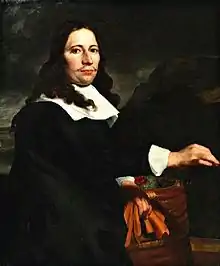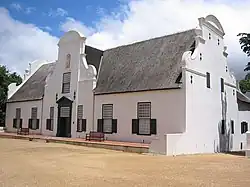Simon van der Stel
Simon van der Stel (14 October 1639 – 24 June 1712) was the first Governor of the Dutch Cape Colony (1691), the settlement at the Cape of Good Hope. He was interested in botany, establishing vineyards Groot and Klein Constantia, and producing a famous dessert wine. He is considered one of the founders of South African viticulture.
Simon van der Stel | |
|---|---|
 Portrait of Van der Stel by Pieter van Anraedt | |
| 1st Governor of the Dutch Cape Colony | |
| In office 1 June 1691 – 2 November 1699 | |
| Preceded by | Himself, as commander |
| Succeeded by | Willem Adriaan van der Stel |
| Commander 10 December 1679 – 1 June 1691 | |
| Preceded by | Hendrik Crudop (acting) |
| Succeeded by | Himself, as governor |
| Personal details | |
| Born | 14 October 1639 Born at sea, Indian Ocean |
| Died | 24 June 1712 (aged 72) Constantia, Cape Colony |
| Spouse | Johanna Jacoba Six |
| Children | Willem Adriaan van der Stel |
| Parent |
|
| Employer | Dutch East India Company |
Background
Simon was the son of Ariaen or Adriaan van der Stel an official of the Dutch East India Company (VOC) and Maria Lievens, who married in March 1639 in Batavia. His mother, a mestiço, was the daughter of Hendrick Lievens and a (Malay or Indian) freed slave.[1] In the same year Adriaan was appointed the first Dutch governor of Mauritius. Adriaan replaced 'Onderkoopman' Pieter de Goijer who was sent by the Dutch East India Company in 1638 with 25 men and cattle, sheep, geese, chickens and rabbits to start the new refreshment station for the Company.[2] Simon was born at sea while his father was en route to take up his new posting on the island; Simon spent his youth there.[3] Adriaan's governorship ended in 1645 [4] when he left Mauritius and transferred to Dutch Ceylon. He was murdered in 1646 by the troops of Rajasinha II of Kandy and his mother died in 1651. Simon was sent on to Batavia, capital of the Dutch East Indies, where he remained until he was 20 years old.
Career
Simon then went to the United Provinces, where he associated with Willem Six, a wealthy cloth dealer. In 1663 he married Willem's daughter, Johanna Jacoba Six (1645–1700) and they had six children. She was the niece of Thymen and Jacob J. Hinlopen, founders of the VOC and Noordsche Compagnie, besides known as art collectors.
In 1679, he was appointed "Commander" of the VOC's colony at the Cape of Good Hope, through the growing influence of his relative, Joan Huydecoper van Maarsseveen, a mayor and an amateur botanist.[5] Simon was involved in making wine in Muiderberg; when he left the country, he handed the vineyards over to Hendrik van Rheede, the former governor of Malabar region and a famous botanist.[6]


Van der Stel and his wife did not enjoy a very good relationship and her sister Cornelia accompanied her husband to the Cape. Van der Stel never saw his wife again, though he remained devoted to her and frequently sent her money. Johanna Jacoba sent the furnishings and works of art required to fit out the governor's residence at Groot Constantia. These included several art works including The Fisherman, an unfinished painting by Simon de Vlieger, which was one of 13 of his works purchased by Jan van de Cappelle.
.jpg.webp)
In 1685 he started Klein Constantia and was visited by Hendrik van Rheede with whom he shared in great interest in tropical medicine and botany. To prevent competition anywhere else in the world, especially in the recent acquired Suriname (Dutch colony), young cinnamon, cloves and camphor trees were destroyed by the ambitious son of Rijckloff van Goens.[7] In 1685–86, he left the remains of his farm and took part in an expedition to the Copper Mountains at Springbok (Namaqualand), where he made topographic and geographic, botanical and zoological observations.[8] In 1691, the VOC replaced the office of "Commander" with "Governor", and Van der Stel was promoted to the new position. His house, Groot Constantia, was well furnished with fine paintings, including The Fisherman. The painting came up for sale at the auction of Van der Stel's estate in 1716.[3]
Every one of his four sons was at one time or another with him in South Africa. Willem Adriaan, after being magistrate of Amsterdam, succeeded his father as Governor of the Cape; Frans "de jonker" became a farmer at the Cape; Adrian became governor of Amboyna (1706–1720); Cornelis was one of the 352 shipwrecked in the Ridderschap van Holland in 1694.[9] An expedition under Willem de Vlamingh was sent out to look for survivors on islands in the Indian Ocean or on the coast of Western Australia.
Van der Stel retired in 1699, and was succeeded by his son Willem Adriaan van der Stel.[10] In retirement, Simon devoted himself to his wine estates (known as Constantia), where he died in 1712. François Valentijn visited his son Frans in March 1714.[11] The estate was sold in parts (also Bergvliet) in 1716; the auction took four days and was very well attended.
Legacy



The town of Stellenbosch (founded in 1679) was named after him and Simon's Town is also named after him, as well as the Simonsberg mountain. An early ship of the South African Navy, SAS Simon van der Stel was also named for him, in 1952.
Jean-Jacques Rousseau, in his Discourse on Inequality, refers to Governor Van der Stel by name in a story about a Hottentot raised by the Dutch who chooses to "return to his equals" rather than remain in civilised society. According to Rousseau, Van der Stel himself raised the "Hottentot" from birth "in the principles of the Christian religion and in the practices of European customs". The frontispiece of the Discourse features Van der Stel and the "Hottentot" above the phrase, Il retourne chez ses Egaux.
Widely known for his development of the South African wine industry, Van der Stel was also the first Cape Governor to be of mixed race-origin, a fact that was largely unacknowledged by the apartheid government.[12]
References
- {{Cite In effect, Simon Van der Stel, the founding father of the modern Afrikaner national was of coloured race. In modern South Africa where coloureds are classified as black, his heritage will be very interesting and controversial considering the apartheid system that his people instituted. web|last=Wallis|first=F|date=2000|title=Nuusdagboek: Feite en Fratse oor 1000 jaar.|url=https://www.sahistory.org.za/dated-event/simon-van-der-stel-commander-and-governor-cape-born%7Curl-status=live%7Caccess-date=27 April 2021}}
- Sleigh, D. (2004). Die Buiteposte: VOC-Buiteposte onder Kaapse bestuur 1652-1795. p.642. ...
- "Simon van der Stel and the Development of Cape Town". Archived from the original on 26 April 2002. Retrieved 10 April 2010.
- Sleigh, D. (2004). Die Buiteposte: VOC-Buiteposte onder Kaapse bestuur 1652-1795. p.642. ...
- Richard H. Grove (1996) Green Imperialism, p. 138.
- "Simon van der Stel" (PDF). lib.ugent.be. p. 13.
- Heniger, J. (1986) Hendrik Adriaan van Reede tot Drakenstein (1636–1691) and Hortus Malabaricus – A contribution to the history of Dutch colonial botany, pp. 71–72.
- See the facsimile of his illustrated manuscript on this expedition, ed. by M.L. Wilson and WJJ van Rijssen: Codex Witsenii. Annotated watercolours of landscapes, flora and fauna observed on the expedition to the Copper Mountains, Namaqua, 1685-6 by Simon van der Stel, Cape Town: Iziko Museums, 2002.
- "De VOCsite: gegevens VOC-schip Ridderschap Van Holland (1681)".
- Gunn, Mary (1981). Botanical exploration of southern Africa : an illustrated history of early botanical literature on the Cape flora : biographical accounts of the leading plant collectors and their activities in southern Africa from the days of the East India Company until modern times. L. E. W. Codd. Cape Town: Published for the Botanical Research Institute by A.A. Balkema. p. 32. ISBN 0-86961-129-1. OCLC 8591273.
- Ron Habiboe (2004) Tot verheffing van mijne natie. Het leven en werk van François Valentijn (1666–1727), p. 75. ISBN 90-5194-262-1
- "Simon van der Stel, commander and governor of the Cape, is born". South African History Online.
